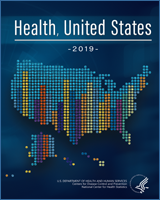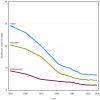Life Expectancy
The gap in life expectancy at birth between white persons and black persons persists but has narrowed since 1990.
Life expectancy is a measure often used to gauge the overall health of a population. As a summary measure of mortality, life expectancy represents the average number of years of life that could be expected if current death rates were to remain constant. Shifts in life expectancy are often used to describe trends in mortality. Life expectancy at birth is strongly influenced by infant and child mortality. Life expectancy later in life reflects death rates at or above a given age and is independent of the effect of mortality at younger ages (1).
From 1900 through 2006, life expectancy at birth increased from 46 to 75 years for men and from 48 to 80 years for women (Table 24). Life expectancy at age 65 also increased during this period (2). Among men, life expectancy at age 65 rose from 13 to 17 years, and among women from 15 to 20 years, from 1950 through 2006 (Table 24). Improved access to health care, advances in medicine, healthier lifestyles, and better health before age 65 are factors underlying decreased death rates among older Americans.
In 2006, life expectancy at birth was 76 years for white males compared with 70 years for black males, and was 81 years for white females compared with 77 years for black females (data table for Figure 16). Life expectancy at birth increased more for the black than for the white population between 1990 and 2006 (Figure 16). During this period, the gap in life expectancy between white males and black males narrowed from 8 years to 6 years (data table for Figure 16). During the same period, the gap in life expectancy between white females and black females decreased from 6 years to 4 years.
The gap in life expectancy between white and black people at age 65 years is narrower than at birth. Since 1990, the difference in life expectancy at age 65 between white males and black males has remained a stable 2-year difference. In 2006, life expectancy at age 65 was 17 years for white males and 15 years for black males. The difference in life expectancy between white and black females has also been stable in recent years; in 2006, at age 65, white females and black females could expect to live an additional 20 and 19 years, respectively.
References
- 1.
- Arriaga EE. Measuring and explaining the change in life expectancies. Demography. 1984;21(1):83–96. [PubMed: 6714492]
- 2.
- Fried LP. Epidemiology of aging. Epidemiol Rev. 2000;22(1):95–106. [PubMed: 10939013]
Infant Mortality
After declining substantially between 1950 and 2000, infant, neonatal, and postneonatal mortality rates have remained constant in recent years.
The infant mortality rate—the risk of death during the first year of life—is related to the underlying health of the mother, public health practices, socioeconomic conditions, and the availability and use of appropriate health care for infants and pregnant women. Disorders related to short gestation and low birthweight, and congenital malformations, are the leading causes of death during the neonatal period (less than 28 days of life). Sudden infant death syndrome (SIDS) and congenital malformations rank as the leading causes of infant deaths during the postneonatal period (28 days through 11 months of life) (1). Results from a new analysis of preterm-related causes of death show that 37% of infant deaths in 2005 were due to preterm-related causes (2).
From 2000–2006, there was little progress in lowering the U.S. infant mortality rate. The infant mortality rate decreased 2.6%, from 6.87 per 1,000 live births in 2005 to 6.69 in 2006 (3) (Figure 17). The 2006 infant mortality rate was 77% lower than in 1950 due to annual declines from 1960–2000. Infant mortality rates fell fairly rapidly from 1950 to 1980, then more slowly until 1995, and have declined much more slowly since 1995.
Infant mortality rates have declined for most racial and ethnic groups, but large disparities among the groups remain. During 1995–2006, the infant mortality rate was consistently highest for infants of non-Hispanic black mothers. Infant mortality rates were also high among infants of American Indian or Alaska Native mothers and Puerto Rican mothers. Infants of Central and South American mothers, Asian mothers, and Cuban mothers had lower infant mortality rates (2,3).
References
- 1.
- Heron M. National vital statistics reports. Hyattsville, MD: NCHS; 2007. Deaths: Leading causes for 2004. Available from: http://www
.cdc.gov/nchs /data/nvsr/nvsr56/nvsr56_05.pdf. [PubMed: 18092547] - 2.
- Mathews TJ, MacDorman MF. National vital statistics reports. Hyattsville, MD: NCHS; 2008. Infant mortality statistics from the 2005 period linked birth/infant death data set. Available from: http://www
.cdc.gov/nchs /data/nvsr/nvsr57/nvsr57_02.pdf. [PubMed: 18972721] - 3.
- Heron M, Hoyert DL, Murphy SL, Xu J, Kochanek KD, Tejada-Vera B. National vital statistics reports. Hyattsville, MD: NCHS; 2009. Deaths: Final data for 2006. Available from: http://www
.cdc.gov/nchs /data/nvsr/nvsr57/nvsr57_14.pdf. [PubMed: 19788058]
Leading Causes of Death for All Ages
Mortality from heart disease, stroke, and unintentional injuries is substantially lower than in 1950.
In 2006, a total of 2.4 million deaths were reported in the United States (Table 28). The overall age-adjusted death rate was 46% lower in 2006 than in 1950 (Figure 18). The reduction in overall mortality since 1950 was driven mostly by declines in mortality from heart disease, stroke, and unintentional injuries (Figure 18).
In 2006, the age-adjusted death rate for heart disease—the leading cause of death—was 66% lower than the rate in 1950 (Figure 18 and Table 32). The age-adjusted death rate for stroke (cerebrovascular disease), the third leading cause of death, had declined 76% since 1950 (Table 33). Heart disease and stroke mortality are associated with risk factors such as diabetes, high cholesterol, high blood pressure, smoking, and dietary factors (1,2). Other important factors include socioeconomic status, obesity, and physical inactivity. Factors contributing to the decline in heart disease and stroke mortality include better control of risk factors, improved access to screening, increased early detection, and better treatment and care, including new drugs and expanded uses for existing drugs (2).
Overall age-adjusted death rates for cancer, the second leading cause of death, rose between 1960 and 1990 and then declined (Figure 18 and Table 34). Between 1990 and 2006, overall death rates for cancer declined 16%. The trend in the overall cancer death rate reflects in part the trend in the death rate for lung cancer (Table 35). Since 1970, the death rate for lung cancer for the total population has been higher than the death rate for any other cancer site.
Chronic lower respiratory diseases (CLRD) were the fourth leading cause of death in 2006. CLRD included deaths from bronchitis, emphysema, and asthma. The age-adjusted death rate for CLRD in 2006 was 43% higher than the rate in 1980 (Figure 18 and Table 37).
The fifth leading cause of death in 2006 was unintentional injuries. Age-adjusted death rates for unintentional injuries declined during the period 1950–1992 (Figure 18 and Table 26). Since 1992, the unintentional injury mortality rate has gradually increased. Despite recent increases, the death rate for unintentional injuries in 2006 was 49% lower than in 1950.
The sixth leading cause of death in 2006 was diabetes. Following a period of decline in the 1970s and some fluctuation in the early 1980s, the age-adjusted death rate for diabetes increased 48% between 1986 and 2002 (Figure 18). As the prevalence of diabetes increases (also see Table 51), there have been efforts to improve reporting of diabetes on death certificates, and changes in death rates for diabetes over time may reflect those efforts (3). The rate has decreased slightly since 2002. The rate in 2006 was 8% lower than the rate in 2002.
References
- 1.
- CDC. Declining prevalence of no known major risk factors for heart disease and stroke among adults—United States, 1991–2001. MMWR . 2004. pp. 4–7. Available from: http://www
.cdc.gov/mmwr /preview/mmwrhtml/mm5301a2.htm. [PubMed: 14724558] - 2.
- CDC. Achievements in public health, 1900–1999: Decline in deaths from heart disease and stroke—United States, 1900–1999. MMWR . 1999. pp. 649–56. Available from: http://www
.cdc.gov/mmwr /preview/mmwrhtml/mm4830a1.htm. [PubMed: 10488780] - 3.
- Kochanek KD, Hudson BL. Monthly vital statistics report. Hyattsville, MD: NCHS; 1995. Advance report of final mortality statistics, 1992. Available from: http://www
.cdc.gov/nchs /data/mvsr/supp/mv43_06s.pdf.
- Mortality - Health, United States, 2009Mortality - Health, United States, 2009
Your browsing activity is empty.
Activity recording is turned off.
See more...




